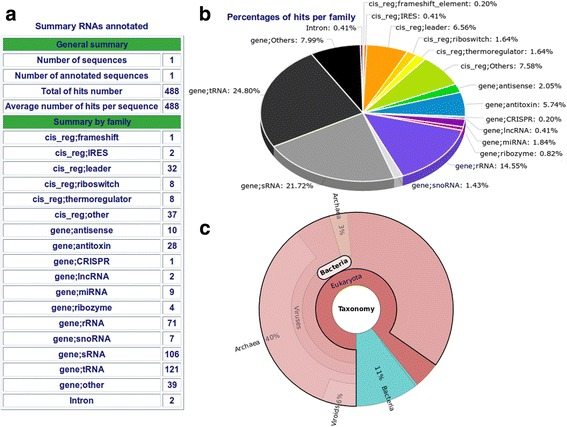StructRNAfinder: an automated pipeline and web server for RNA families prediction.
The function of many noncoding RNAs (ncRNAs) depend upon their secondary structures. Over the last decades, several methodologies have been developed to predict such structures or to use them to functionally annotate RNAs into RNA families. However, to fully perform this analysis, researchers should utilize multiple tools, which require the constant parsing and processing of several intermediate files. This makes the large-scale prediction and annotation of RNAs a daunting task even to researchers with good computational or bioinformatics skills. We present an automated pipeline named StructRNAfinder that predicts and annotates RNA families in transcript or genome sequences. This single tool not only displays the sequence/structural consensus alignments for each RNA family, according to Rfam database but also provides a taxonomic overview for each assigned functional RNA. Moreover, we implemented a user-friendly web service that allows researchers to upload their own nucleotide sequences in order to perform the whole analysis. Finally, we provided a stand-alone version of StructRNAfinder to be used in large-scale projects. The tool was developed under GNU General Public License (GPLv3) and is freely available at http://structrnafinder.integrativebioinformatics.me . The main advantage of StructRNAfinder relies on the large-scale processing and integrating the data obtained by each tool and database employed along the workflow, of which several files are generated and displayed in user-friendly reports, useful for downstream analyses and data exploration.
Authors
Raúl Arias-Carrasco; Yessenia Vásquez-Morán; Helder I Nakaya; Vinicius Maracaja-Coutinho
External link
Publication Year
Publication Journal
Associeted Project
User-friendly computational Tools
Lista de serviços
-
Gene regulatory and signaling networks exhibit distinct topological distributions of motifs.Gene regulatory and signaling networks exhibit distinct topological distributions of motifs.
-
Gene signatures of autopsy lungs from obese patients with COVID-19.Gene signatures of autopsy lungs from obese patients with COVID-19.
-
Network Medicine: Methods and ApplicationsNetwork Medicine: Methods and Applications
-
ACE2 Expression Is Increased in the Lungs of Patients With Comorbidities Associated With Severe COVID-19.ACE2 Expression Is Increased in the Lungs of Patients With Comorbidities Associated With Severe COVID-19.
-
Drug repositioning for psychiatric and neurological disorders through a network medicine approach.Drug repositioning for psychiatric and neurological disorders through a network medicine approach.
-
Linking proteomic alterations in schizophrenia hippocampus to NMDAr hypofunction in human neurons and oligodendrocytes.Linking proteomic alterations in schizophrenia hippocampus to NMDAr hypofunction in human neurons and oligodendrocytes.
-
In-depth analysis of laboratory parameters reveals the interplay between sex, age, and systemic inflammation in individuals with COVID-19.In-depth analysis of laboratory parameters reveals the interplay between sex, age, and systemic inflammation in individuals with COVID-19.
-
The evolution of knowledge on genes associated with human diseasesThe evolution of knowledge on genes associated with human diseases
-
Network vaccinology.Network vaccinology.
-
Pyruvate kinase M2 mediates IL-17 signaling in keratinocytes driving psoriatic skin inflammationPyruvate kinase M2 mediates IL-17 signaling in keratinocytes driving psoriatic skin inflammation
-
Transcriptome analysis of six tissues obtained post-mortem from sepsis patientsTranscriptome analysis of six tissues obtained post-mortem from sepsis patients
-
Gene Signatures of Symptomatic and Asymptomatic Clinical-Immunological Profiles of Human Infection by Leishmania (L.) chagasi in Amazonian BrazilGene Signatures of Symptomatic and Asymptomatic Clinical-Immunological Profiles of Human Infection by Leishmania (L.) chagasi in Amazonian Brazil
-
In vitro morphological profiling of T cells predicts clinical response to natalizumab therapy in patients with multiple sclerosis.In vitro morphological profiling of T cells predicts clinical response to natalizumab therapy in patients with multiple sclerosis.
-
Integrative immunology identified interferome signatures in uveitis and systemic disease-associated uveitis.Integrative immunology identified interferome signatures in uveitis and systemic disease-associated uveitis.
-
Gene regulatory networks analysis for the discovery of prognostic genes in gliomas.Gene regulatory networks analysis for the discovery of prognostic genes in gliomas.
-
Revealing shared molecular drivers of brain metastases from distinct primary tumors.Revealing shared molecular drivers of brain metastases from distinct primary tumors.

